belt FIAT IDEA 2009 1.G User Guide
[x] Cancel search | Manufacturer: FIAT, Model Year: 2009, Model line: IDEA, Model: FIAT IDEA 2009 1.GPages: 210, PDF Size: 3.62 MB
Page 97 of 210
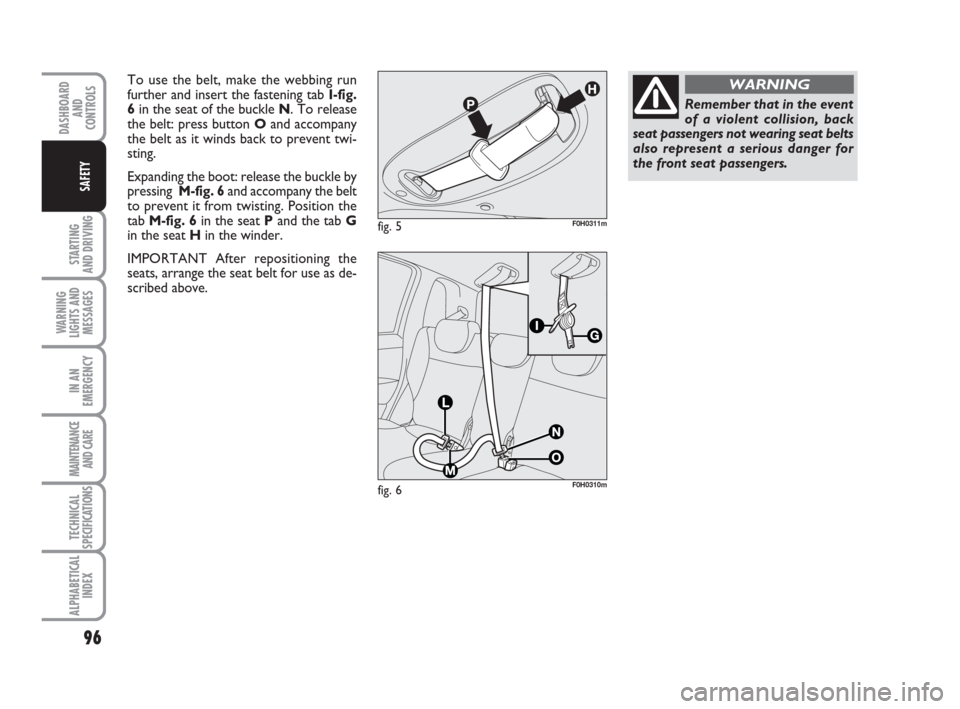
96
STARTING
AND DRIVING
WARNING
LIGHTS AND
MESSAGES
IN AN
EMERGENCY
MAINTENANCE
AND CARE
TECHNICAL
SPECIFICATIONS
ALPHABETICAL
INDEX
DASHBOARD
AND
CONTROLS
SAFETY
fig. 5F0H0311m
To use the belt, make the webbing run
further and insert the fastening tab I-fig.
6in the seat of the buckle N. To release
the belt: press button Oand accompany
the belt as it winds back to prevent twi-
sting.
Expanding the boot: release the buckle by
pressing M-fig. 6and accompany the belt
to prevent it from twisting. Position the
tab M-fig. 6in the seat Pand the tab G
in the seat Hin the winder.
IMPORTANT After repositioning the
seats, arrange the seat belt for use as de-
scribed above.
fig. 6F0H0310m
Remember that in the event
of a violent collision, back
seat passengers not wearing seat belts
also represent a serious danger for
the front seat passengers.
WARNING
Page 98 of 210
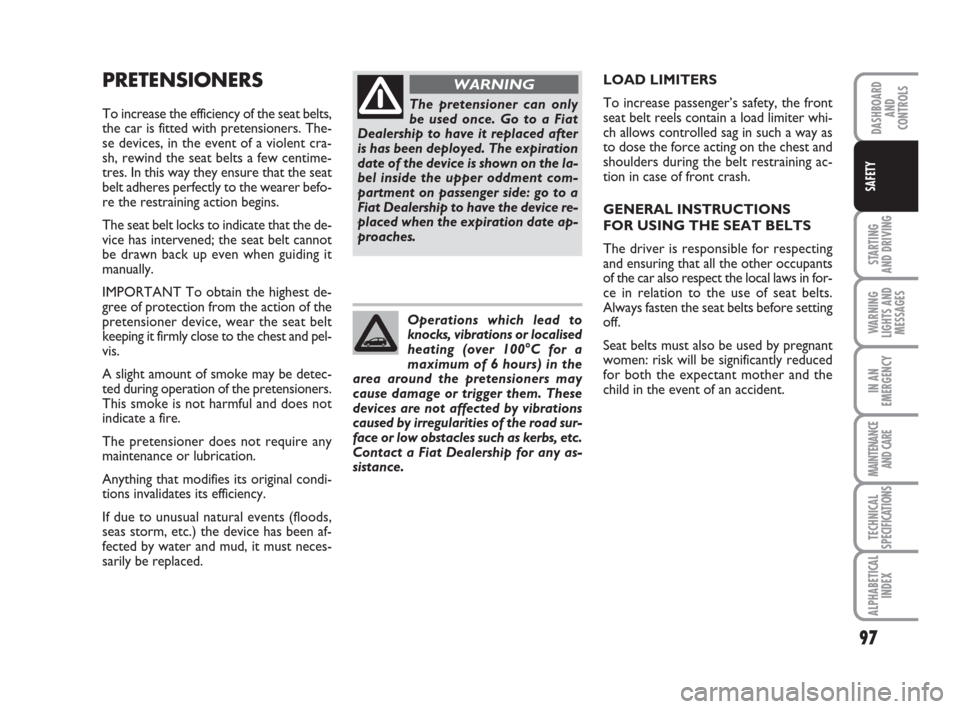
97
STARTING
AND DRIVING
WARNING
LIGHTS AND
MESSAGES
IN AN
EMERGENCY
MAINTENANCE
AND CARE
TECHNICAL
SPECIFICATIONS
ALPHABETICAL
INDEX
DASHBOARD
AND
CONTROLS
SAFETY
PRETENSIONERS
To increase the efficiency of the seat belts,
the car is fitted with pretensioners. The-
se devices, in the event of a violent cra-
sh, rewind the seat belts a few centime-
tres. In this way they ensure that the seat
belt adheres perfectly to the wearer befo-
re the restraining action begins.
The seat belt locks to indicate that the de-
vice has intervened; the seat belt cannot
be drawn back up even when guiding it
manually.
IMPORTANT To obtain the highest de-
gree of protection from the action of the
pretensioner device, wear the seat belt
keeping it firmly close to the chest and pel-
vis.
A slight amount of smoke may be detec-
ted during operation of the pretensioners.
This smoke is not harmful and does not
indicate a fire.
The pretensioner does not require any
maintenance or lubrication.
Anything that modifies its original condi-
tions invalidates its efficiency.
If due to unusual natural events (floods,
seas storm, etc.) the device has been af-
fected by water and mud, it must neces-
sarily be replaced.LOAD LIMITERS
To increase passenger’s safety, the front
seat belt reels contain a load limiter whi-
ch allows controlled sag in such a way as
to dose the force acting on the chest and
shoulders during the belt restraining ac-
tion in case of front crash.
GENERAL INSTRUCTIONS
FOR USING THE SEAT BELTS
The driver is responsible for respecting
and ensuring that all the other occupants
of the car also respect the local laws in for-
ce in relation to the use of seat belts.
Always fasten the seat belts before setting
off.
Seat belts must also be used by pregnant
women: risk will be significantly reduced
for both the expectant mother and the
child in the event of an accident.The pretensioner can only
be used once. Go to a Fiat
Dealership to have it replaced after
is has been deployed. The expiration
date of the device is shown on the la-
bel inside the upper oddment com-
partment on passenger side: go to a
Fiat Dealership to have the device re-
placed when the expiration date ap-
proaches.
WARNING
Operations which lead to
knocks, vibrations or localised
heating (over 100°C for a
maximum of 6 hours) in the
area around the pretensioners may
cause damage or trigger them. These
devices are not affected by vibrations
caused by irregularities of the road sur-
face or low obstacles such as kerbs, etc.
Contact a Fiat Dealership for any as-
sistance.
Page 99 of 210
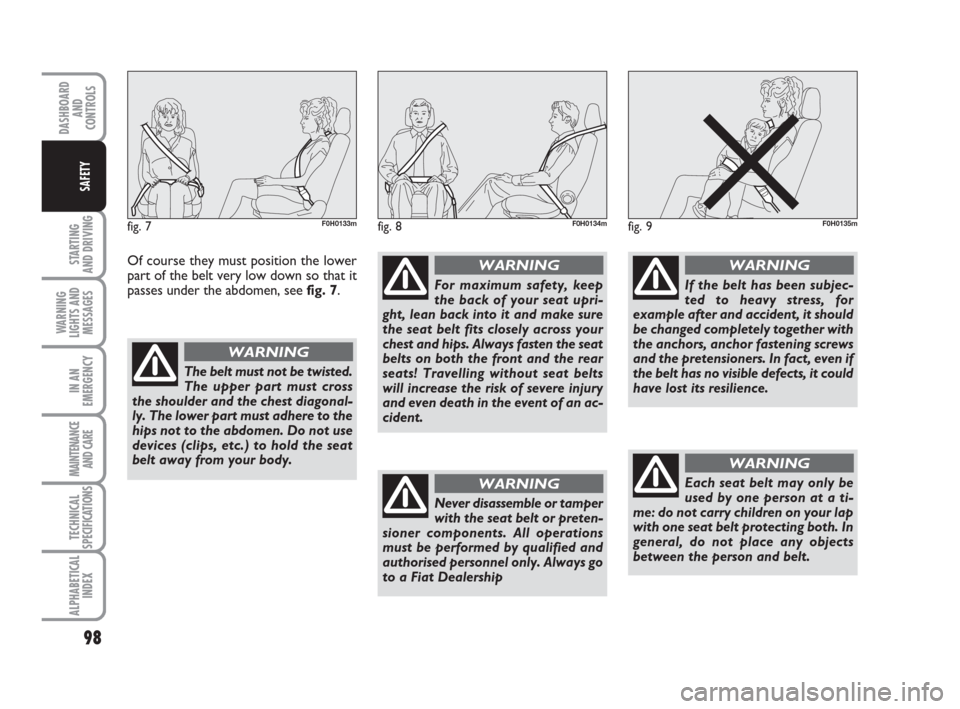
98
STARTING
AND DRIVING
WARNING
LIGHTS AND
MESSAGES
IN AN
EMERGENCY
MAINTENANCE
AND CARE
TECHNICAL
SPECIFICATIONS
ALPHABETICAL
INDEX
DASHBOARD
AND
CONTROLS
SAFETY
fig. 7F0H0133mfig. 8F0H0134mfig. 9F0H0135m
The belt must not be twisted.
The upper part must cross
the shoulder and the chest diagonal-
ly. The lower part must adhere to the
hips not to the abdomen. Do not use
devices (clips, etc.) to hold the seat
belt away from your body.
WARNING
For maximum safety, keep
the back of your seat upri-
ght, lean back into it and make sure
the seat belt fits closely across your
chest and hips. Always fasten the seat
belts on both the front and the rear
seats! Travelling without seat belts
will increase the risk of severe injury
and even death in the event of an ac-
cident.
WARNING
Never disassemble or tamper
with the seat belt or preten-
sioner components. All operations
must be performed by qualified and
authorised personnel only. Always go
to a Fiat Dealership
WARNING
If the belt has been subjec-
ted to heavy stress, for
example after and accident, it should
be changed completely together with
the anchors, anchor fastening screws
and the pretensioners. In fact, even if
the belt has no visible defects, it could
have lost its resilience.
WARNING
Each seat belt may only be
used by one person at a ti-
me: do not carry children on your lap
with one seat belt protecting both. In
general, do not place any objects
between the person and belt.
WARNING
Of course they must position the lower
part of the belt very low down so that it
passes under the abdomen, see fig. 7.
Page 100 of 210
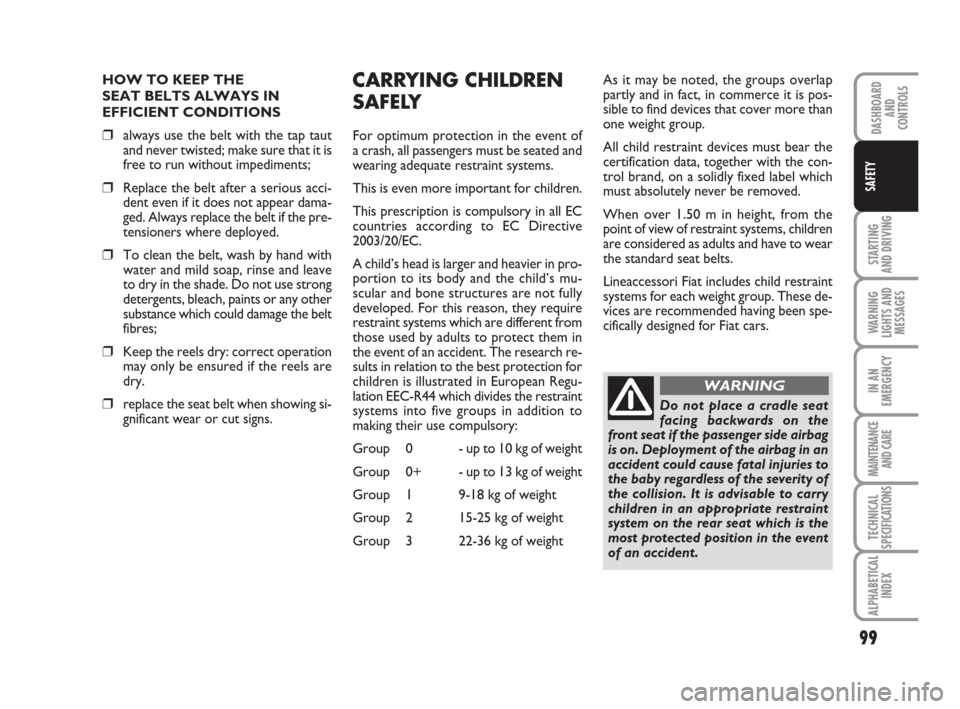
99
STARTING
AND DRIVING
WARNING
LIGHTS AND
MESSAGES
IN AN
EMERGENCY
MAINTENANCE
AND CARE
TECHNICAL
SPECIFICATIONS
ALPHABETICAL
INDEX
DASHBOARD
AND
CONTROLS
SAFETY
HOW TO KEEP THE
SEAT BELTS ALWAYS IN
EFFICIENT CONDITIONS
❒always use the belt with the tap taut
and never twisted; make sure that it is
free to run without impediments;
❒Replace the belt after a serious acci-
dent even if it does not appear dama-
ged. Always replace the belt if the pre-
tensioners where deployed.
❒To clean the belt, wash by hand with
water and mild soap, rinse and leave
to dry in the shade. Do not use strong
detergents, bleach, paints or any other
substance which could damage the belt
fibres;
❒Keep the reels dry: correct operation
may only be ensured if the reels are
dry.
❒replace the seat belt when showing si-
gnificant wear or cut signs.
CARRYING CHILDREN
SAFELY
For optimum protection in the event of
a crash, all passengers must be seated and
wearing adequate restraint systems.
This is even more important for children.
This prescription is compulsory in all EC
countries according to EC Directive
2003/20/EC.
A child’s head is larger and heavier in pro-
portion to its body and the child’s mu-
scular and bone structures are not fully
developed. For this reason, they require
restraint systems which are different from
those used by adults to protect them in
the event of an accident. The research re-
sults in relation to the best protection for
children is illustrated in European Regu-
lation EEC-R44 which divides the restraint
systems into five groups in addition to
making their use compulsory:
Group 0 - up to 10 kg of weight
Group 0+ - up to 13 kg of weight
Group 1 9-18 kg of weight
Group 2 15-25 kg of weight
Group 3 22-36 kg of weightAs it may be noted, the groups overlap
partly and in fact, in commerce it is pos-
sible to find devices that cover more than
one weight group.
All child restraint devices must bear the
certification data, together with the con-
trol brand, on a solidly fixed label which
must absolutely never be removed.
When over 1.50 m in height, from the
point of view of restraint systems, children
are considered as adults and have to wear
the standard seat belts.
Lineaccessori Fiat includes child restraint
systems for each weight group. These de-
vices are recommended having been spe-
cifically designed for Fiat cars.
Do not place a cradle seat
facing backwards on the
front seat if the passenger side airbag
is on. Deployment of the airbag in an
accident could cause fatal injuries to
the baby regardless of the severity of
the collision. It is advisable to carry
children in an appropriate restraint
system on the rear seat which is the
most protected position in the event
of an accident.
WARNING
Page 101 of 210
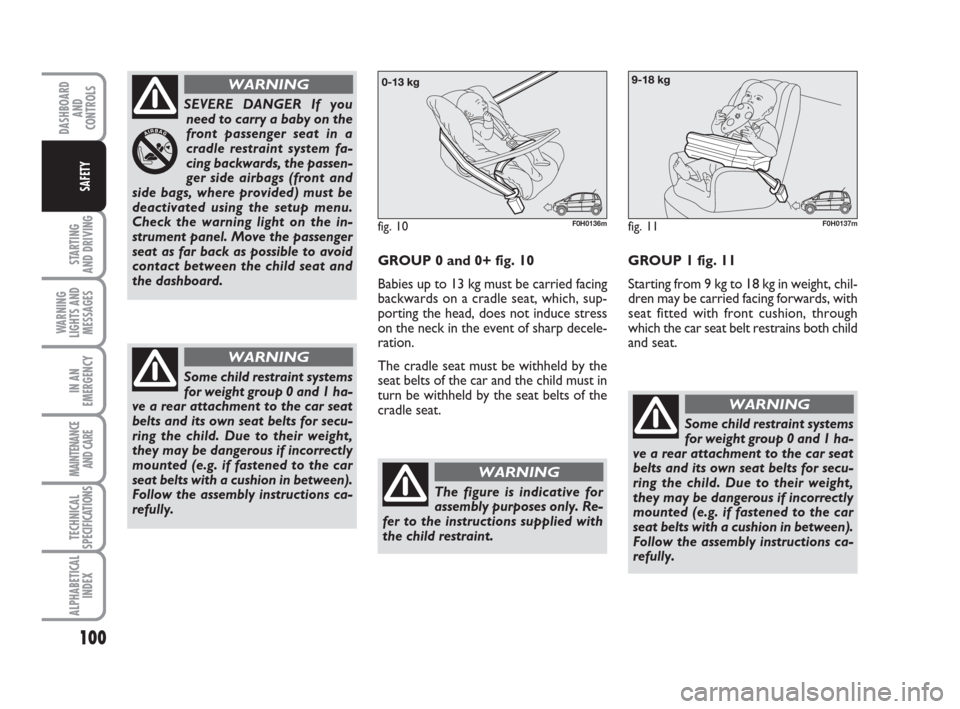
100
STARTING
AND DRIVING
WARNING
LIGHTS AND
MESSAGES
IN AN
EMERGENCY
MAINTENANCE
AND CARE
TECHNICAL
SPECIFICATIONS
ALPHABETICAL
INDEX
DASHBOARD
AND
CONTROLS
SAFETY
SEVERE DANGER If you
need to carry a baby on the
front passenger seat in a
cradle restraint system fa-
cing backwards, the passen-
ger side airbags (front and
side bags, where provided) must be
deactivated using the setup menu.
Check the warning light on the in-
strument panel. Move the passenger
seat as far back as possible to avoid
contact between the child seat and
the dashboard.
WARNING
GROUP 0 and 0+ fig. 10
Babies up to 13 kg must be carried facing
backwards on a cradle seat, which, sup-
porting the head, does not induce stress
on the neck in the event of sharp decele-
ration.
The cradle seat must be withheld by the
seat belts of the car and the child must in
turn be withheld by the seat belts of the
cradle seat.
fig. 10F0H0136m
The figure is indicative for
assembly purposes only. Re-
fer to the instructions supplied with
the child restraint.
WARNING
Some child restraint systems
for weight group 0 and 1 ha-
ve a rear attachment to the car seat
belts and its own seat belts for secu-
ring the child. Due to their weight,
they may be dangerous if incorrectly
mounted (e.g. if fastened to the car
seat belts with a cushion in between).
Follow the assembly instructions ca-
refully.
WARNING
fig. 11F0H0137m
GROUP 1 fig. 11
Starting from 9 kg to 18 kg in weight, chil-
dren may be carried facing forwards, with
seat fitted with front cushion, through
which the car seat belt restrains both child
and seat.
Some child restraint systems
for weight group 0 and 1 ha-
ve a rear attachment to the car seat
belts and its own seat belts for secu-
ring the child. Due to their weight,
they may be dangerous if incorrectly
mounted (e.g. if fastened to the car
seat belts with a cushion in between).
Follow the assembly instructions ca-
refully.
WARNING
Page 102 of 210
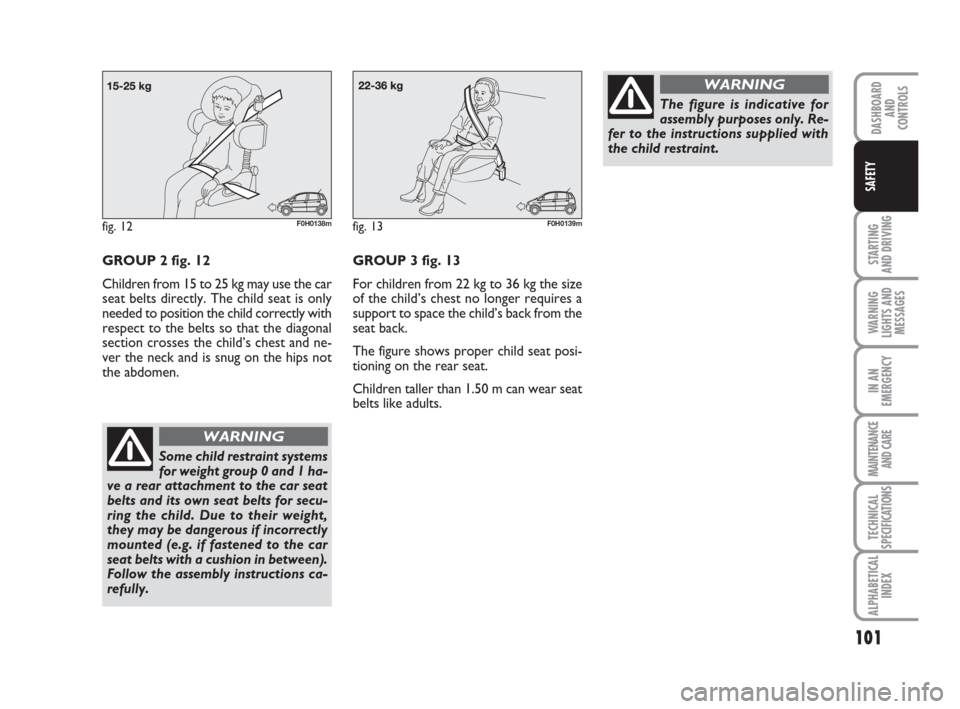
101
STARTING
AND DRIVING
WARNING
LIGHTS AND
MESSAGES
IN AN
EMERGENCY
MAINTENANCE
AND CARE
TECHNICAL
SPECIFICATIONS
ALPHABETICAL
INDEX
DASHBOARD
AND
CONTROLS
SAFETY
fig. 12F0H0138m
GROUP 2 fig. 12
Children from 15 to 25 kg may use the car
seat belts directly. The child seat is only
needed to position the child correctly with
respect to the belts so that the diagonal
section crosses the child’s chest and ne-
ver the neck and is snug on the hips not
the abdomen.
Some child restraint systems
for weight group 0 and 1 ha-
ve a rear attachment to the car seat
belts and its own seat belts for secu-
ring the child. Due to their weight,
they may be dangerous if incorrectly
mounted (e.g. if fastened to the car
seat belts with a cushion in between).
Follow the assembly instructions ca-
refully.
WARNING
fig. 13F0H0139m
The figure is indicative for
assembly purposes only. Re-
fer to the instructions supplied with
the child restraint.
WARNING
GROUP 3 fig. 13
For children from 22 kg to 36 kg the size
of the child’s chest no longer requires a
support to space the child’s back from the
seat back.
The figure shows proper child seat posi-
tioning on the rear seat.
Children taller than 1.50 m can wear seat
belts like adults.
Page 104 of 210
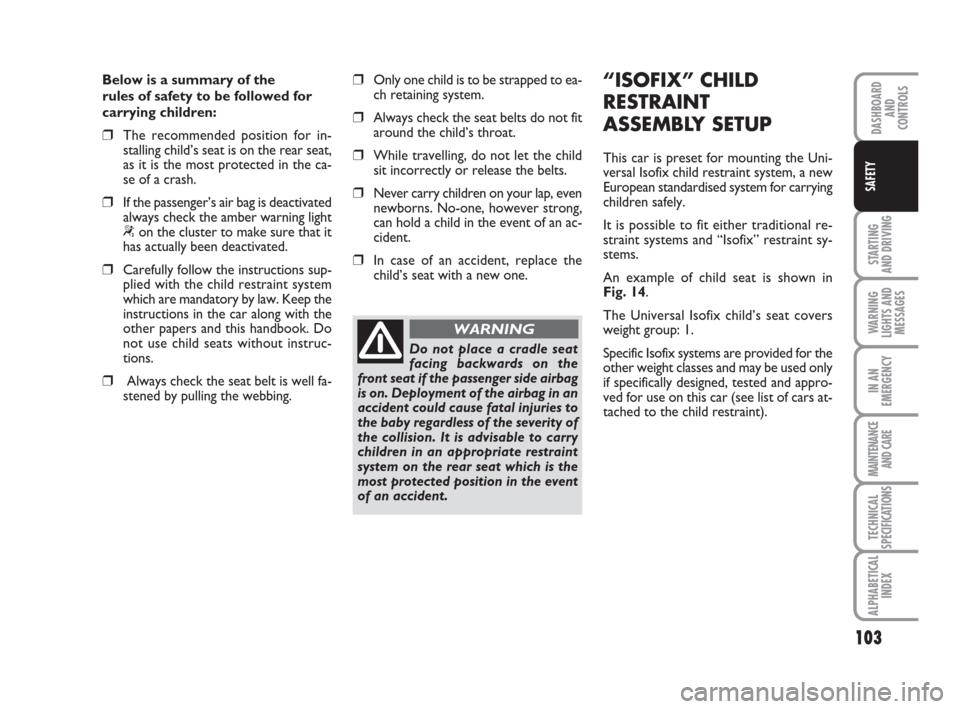
103
STARTING
AND DRIVING
WARNING
LIGHTS AND
MESSAGES
IN AN
EMERGENCY
MAINTENANCE
AND CARE
TECHNICAL
SPECIFICATIONS
ALPHABETICAL
INDEX
DASHBOARD
AND
CONTROLS
SAFETY
Below is a summary of the
rules of safety to be followed for
carrying children:
❒The recommended position for in-
stalling child’s seat is on the rear seat,
as it is the most protected in the ca-
se of a crash.
❒If the passenger’s air bag is deactivated
always check the amber warning light
“on the cluster to make sure that it
has actually been deactivated.
❒Carefully follow the instructions sup-
plied with the child restraint system
which are mandatory by law. Keep the
instructions in the car along with the
other papers and this handbook. Do
not use child seats without instruc-
tions.
❒Always check the seat belt is well fa-
stened by pulling the webbing.
❒Only one child is to be strapped to ea-
ch retaining system.
❒Always check the seat belts do not fit
around the child’s throat.
❒While travelling, do not let the child
sit incorrectly or release the belts.
❒Never carry children on your lap, even
newborns. No-one, however strong,
can hold a child in the event of an ac-
cident.
❒In case of an accident, replace the
child’s seat with a new one.
Do not place a cradle seat
facing backwards on the
front seat if the passenger side airbag
is on. Deployment of the airbag in an
accident could cause fatal injuries to
the baby regardless of the severity of
the collision. It is advisable to carry
children in an appropriate restraint
system on the rear seat which is the
most protected position in the event
of an accident.
WARNING
“ISOFIX” CHILD
RESTRAINT
ASSEMBLY SETUP
This car is preset for mounting the Uni-
versal Isofix child restraint system, a new
European standardised system for carrying
children safely.
It is possible to fit either traditional re-
straint systems and “Isofix” restraint sy-
stems.
An example of child seat is shown in
Fig. 14.
The Universal Isofix child’s seat covers
weight group: 1.
Specific Isofix systems are provided for the
other weight classes and may be used only
if specifically designed, tested and appro-
ved for use on this car (see list of cars at-
tached to the child restraint).
Page 105 of 210
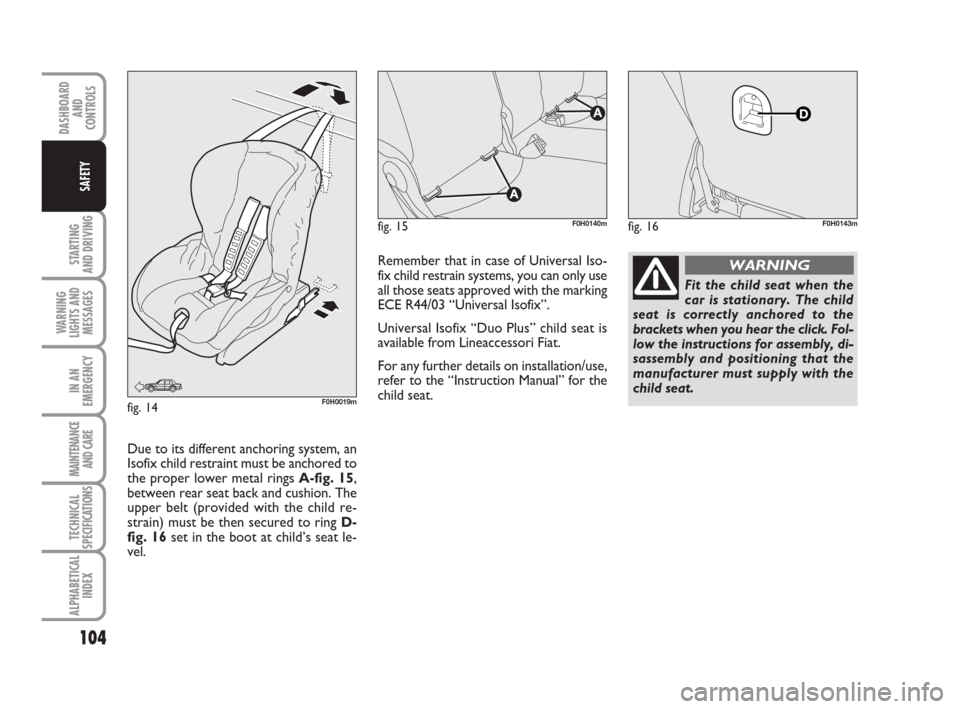
104
STARTING
AND DRIVING
WARNING
LIGHTS AND
MESSAGES
IN AN
EMERGENCY
MAINTENANCE
AND CARE
TECHNICAL
SPECIFICATIONS
ALPHABETICAL
INDEX
DASHBOARD
AND
CONTROLS
SAFETY
fig. 15F0H0140m
Fit the child seat when the
car is stationary. The child
seat is correctly anchored to the
brackets when you hear the click. Fol-
low the instructions for assembly, di-
sassembly and positioning that the
manufacturer must supply with the
child seat.
WARNING
fig. 14F0H0019m
Due to its different anchoring system, an
Isofix child restraint must be anchored to
the proper lower metal rings A-fig. 15,
between rear seat back and cushion. The
upper belt (provided with the child re-
strain) must be then secured to ring D-
fig. 16set in the boot at child’s seat le-
vel.
fig. 16F0H0143m
Remember that in case of Universal Iso-
fix child restrain systems, you can only use
all those seats approved with the marking
ECE R44/03 “Universal Isofix”.
Universal Isofix “Duo Plus” child seat is
available from Lineaccessori Fiat.
For any further details on installation/use,
refer to the “Instruction Manual” for the
child seat.
Page 107 of 210
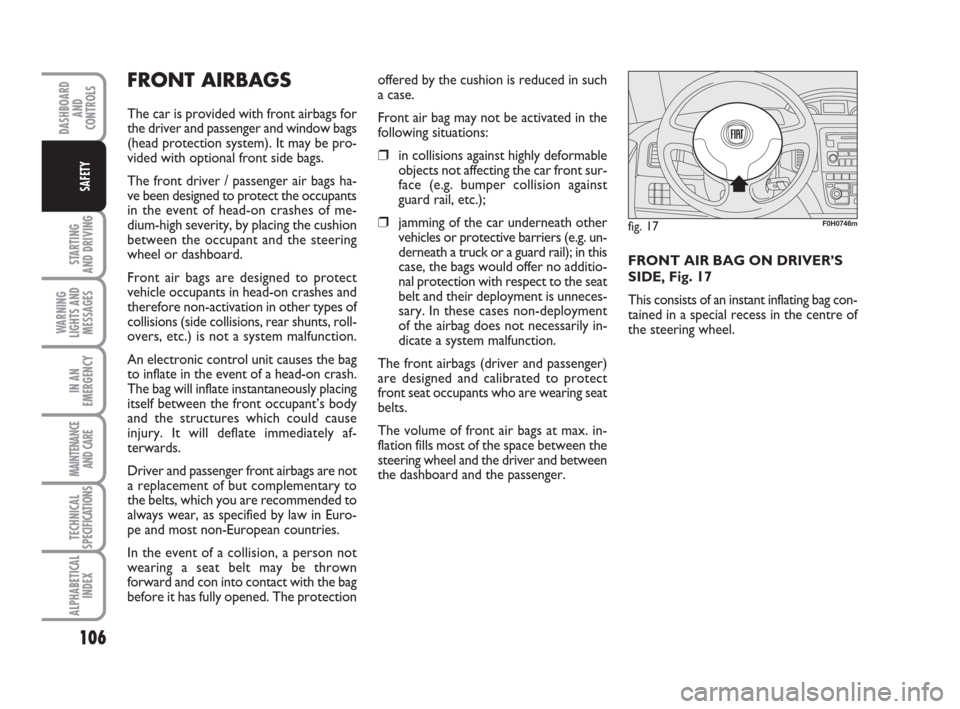
106
STARTING
AND DRIVING
WARNING
LIGHTS AND
MESSAGES
IN AN
EMERGENCY
MAINTENANCE
AND CARE
TECHNICAL
SPECIFICATIONS
ALPHABETICAL
INDEX
DASHBOARD
AND
CONTROLS
SAFETY
FRONT AIRBAGS
The car is provided with front airbags for
the driver and passenger and window bags
(head protection system). It may be pro-
vided with optional front side bags.
The front driver / passenger air bags ha-
ve been designed to protect the occupants
in the event of head-on crashes of me-
dium-high severity, by placing the cushion
between the occupant and the steering
wheel or dashboard.
Front air bags are designed to protect
vehicle occupants in head-on crashes and
therefore non-activation in other types of
collisions (side collisions, rear shunts, roll-
overs, etc.) is not a system malfunction.
An electronic control unit causes the bag
to inflate in the event of a head-on crash.
The bag will inflate instantaneously placing
itself between the front occupant’s body
and the structures which could cause
injury. It will deflate immediately af-
terwards.
Driver and passenger front airbags are not
a replacement of but complementary to
the belts, which you are recommended to
always wear, as specified by law in Euro-
pe and most non-European countries.
In the event of a collision, a person not
wearing a seat belt may be thrown
forward and con into contact with the bag
before it has fully opened. The protectionoffered by the cushion is reduced in such
a case.
Front air bag may not be activated in the
following situations:
❒in collisions against highly deformable
objects not affecting the car front sur-
face (e.g. bumper collision against
guard rail, etc.);
❒jamming of the car underneath other
vehicles or protective barriers (e.g. un-
derneath a truck or a guard rail); in this
case, the bags would offer no additio-
nal protection with respect to the seat
belt and their deployment is unneces-
sary. In these cases non-deployment
of the airbag does not necessarily in-
dicate a system malfunction.
The front airbags (driver and passenger)
are designed and calibrated to protect
front seat occupants who are wearing seat
belts.
The volume of front air bags at max. in-
flation fills most of the space between the
steering wheel and the driver and between
the dashboard and the passenger.FRONT AIR BAG ON DRIVER’S
SIDE, Fig. 17
This consists of an instant inflating bag con-
tained in a special recess in the centre of
the steering wheel.fig. 17F0H0746m
Page 108 of 210
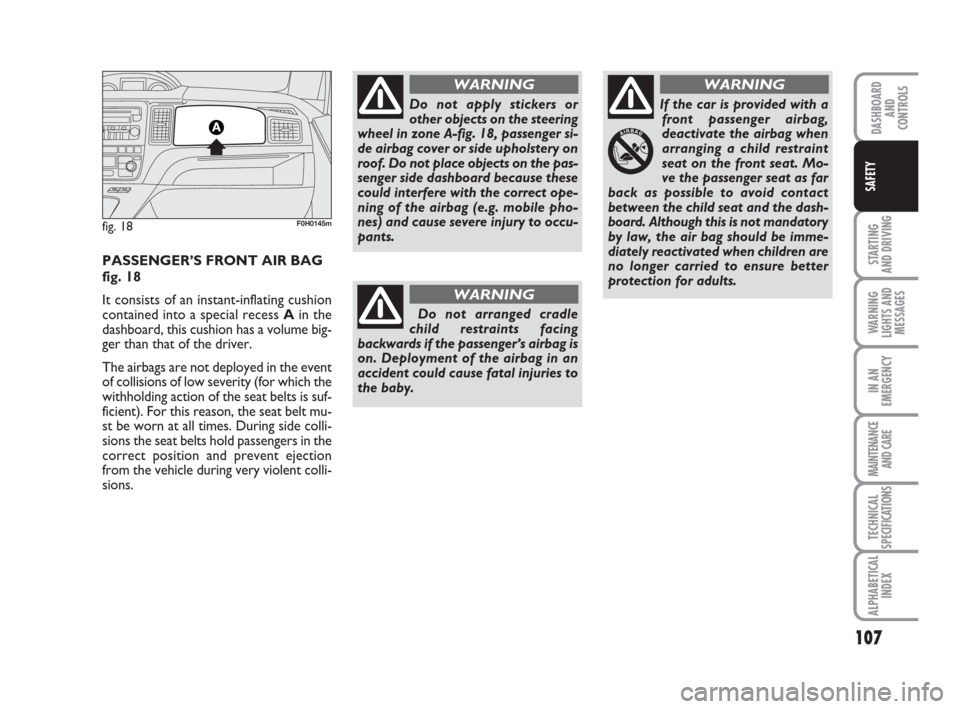
107
STARTING
AND DRIVING
WARNING
LIGHTS AND
MESSAGES
IN AN
EMERGENCY
MAINTENANCE
AND CARE
TECHNICAL
SPECIFICATIONS
ALPHABETICAL
INDEX
DASHBOARD
AND
CONTROLS
SAFETY
fig. 18F0H0145m
PASSENGER’S FRONT AIR BAG
fig. 18
It consists of an instant-inflating cushion
contained into a special recess Ain the
dashboard, this cushion has a volume big-
ger than that of the driver.
The airbags are not deployed in the event
of collisions of low severity (for which the
withholding action of the seat belts is suf-
ficient). For this reason, the seat belt mu-
st be worn at all times. During side colli-
sions the seat belts hold passengers in the
correct position and prevent ejection
from the vehicle during very violent colli-
sions.
Do not apply stickers or
other objects on the steering
wheel in zone A-fig. 18, passenger si-
de airbag cover or side upholstery on
roof. Do not place objects on the pas-
senger side dashboard because these
could interfere with the correct ope-
ning of the airbag (e.g. mobile pho-
nes) and cause severe injury to occu-
pants.
WARNING
Do not arranged cradle
child restraints facing
backwards if the passenger’s airbag is
on. Deployment of the airbag in an
accident could cause fatal injuries to
the baby.
WARNING
If the car is provided with a
front passenger airbag,
deactivate the airbag when
arranging a child restraint
seat on the front seat. Mo-
ve the passenger seat as far
back as possible to avoid contact
between the child seat and the dash-
board. Although this is not mandatory
by law, the air bag should be imme-
diately reactivated when children are
no longer carried to ensure better
protection for adults.
WARNING